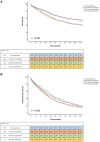Left ventricular remodelling patterns in patients with moderate aortic stenosis
- PMID: 35179595
- PMCID: PMC9463993
- DOI: 10.1093/ehjci/jeac018
Left ventricular remodelling patterns in patients with moderate aortic stenosis
Abstract
Aims: Moderate aortic stenosis (AS) is associated with an increased risk of adverse events. Because outcomes in patients with AS are ultimately driven by the condition of the left ventricle (LV) and not by the valve, assessment of LV remodelling seems important for risk stratification. This study evaluated the association between different LV remodelling patterns and outcomes in patients with moderate AS.
Methods and results: Patients with moderate AS (aortic valve area 1.0-1.5 cm2) were identified and stratified into four groups according to the LV remodelling pattern: normal geometry (NG), concentric remodelling (CR), concentric hypertrophy (CH), or eccentric hypertrophy (EH). Clinical outcomes were defined as all-cause mortality and a composite endpoint of all-cause mortality and aortic valve replacement (AVR). Of 1931 patients with moderate AS (age 73 ± 10 years, 52% men), 344 (18%) had NG, 469 (24%) CR, 698 (36%) CH, and 420 (22%) EH. Patients with CH and EH showed higher 3-year mortality rates (28% and 32%, respectively) when compared with patients with NG (19%) (P < 0.001). After multivariable adjustment, CH remained independently associated with mortality (HR 1.258, 95% CI 1.016-1.558; P = 0.035), whereas both CH (HR 1.291, 95% CI 1.088-1.532; P = 0.003) and EH (HR 1.217, 95% CI 1.008-1.470; P = 0.042) were associated with the composite endpoint of death or AVR.
Conclusion: In patients with moderate AS, those who develop CH already have an increased risk of all-cause mortality. Assessment of the LV remodelling patterns may identify patients at higher risk of adverse events, warranting closer surveillance, and possibly earlier intervention.
Keywords: aortic valve replacement; left ventricular remodelling; moderate aortic stenosis; mortality.
© The Author(s) 2022. Published by Oxford University Press on behalf of the European Society of Cardiology.
Conflict of interest statement
Conflict of interest: The Department of Cardiology of the Leiden University Medical Centre received unrestricted research grants from Abbott Vascular, Bayer, Biotronik, Bioventrix, Boston Scientific, Edwards Lifesciences, GE Healthcare, and Medtronic. J.J.B. received speaker fees from Abbott Vascular. N.A.M. received speaker fees from Abbott Vascular and GE Healthcare. V.D. received speaker fees from Abbott Vascular, Edwards Lifesciences, MSD, and GE Healthcare. The remaining authors have nothing to disclose.
Figures



References
-
- Iung B, Baron G, Butchart EG, Delahaye F, Gohlke-Bärwolf C, Levang OWet al. . A prospective survey of patients with valvular heart disease in Europe: the Euro Heart Survey on Valvular Heart Disease. Eur Heart J 2003;24:1231–43. - PubMed
-
- Osnabrugge RLJ, Mylotte D, Head SJ, Van Mieghem NM, Nkomo VT, LeReun CMet al. . Aortic stenosis in the elderly: disease prevalence and number of candidates for transcatheter aortic valve replacement: a meta-analysis and modeling study. J Am Coll Cardiol 2013;62:1002–12. - PubMed
-
- Horstkotte D, Loogen F.. The natural history of aortic valve stenosis. Eur Heart J 1988;9 Suppl E:57–64. - PubMed
-
- Turina J, Hess O, Sepulcri F, Krayenbuehl HP.. Spontaneous course of aortic valve disease. Eur Heart J 1987;8:471–83. - PubMed
-
- Schwarz F, Baumann P, Manthey J, Hoffmann M, Schuler G, Mehmel HCet al. . The effect of aortic valve replacement on survival. Circulation 1982;66:1105–10. - PubMed
MeSH terms
LinkOut - more resources
Full Text Sources
Medical
Research Materials

